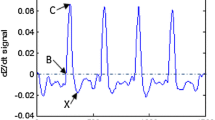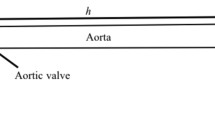Abstract
Impedance cardiographic determination of clinically important cardiac parameters such as systolic time intervals, stroke volume, and related cardiovascular parameters has not yet found adequate application in clinical practice, since its theoretical basis remains controversial, and the precision of beat-to-beat parameter estimation has until recently suffered under severe shortcomings of available signal processing techniques. High levels of noise and motion artifacts deteriorate signal quality and result in poor event detection. To improve the precision of impedance cardiography, new techniques for event detection and parameter estimation have been developed. Specifically, matched filtering and various signal segmentation and decomposition techniques have been tested on impedance signals with various levels of artificially superimposed noise and on actual recordings from subjects in a laboratory study of cardiovascular response to a cognitive challenge. Substantial improvement in the precision of impedance cardiography was obtained using the newly developed signal processing techniques. In addition, some preliminary evidence from comparisons of the impedance cardiogram with invasive aortic electromagnetic flow measurement in anesthetized rabbits is presented to address questions relating to the origin of the impedance signal.
Similar content being viewed by others
References
Appel, P.L.; Kram, H.B.; MacKabee, J.; Flemming, A.W.; Shoemaker, W.C. Comparison of measurements of cardiac output by bioimpedance and thermodilution in severely ill surgical patients. Crit. Care Med. 14:933–935; 1986.
Aust, P.E.; Belz, G.G.;et al. Comparison of impedance cardiography and echocardiography for measurement of stroke volume. Eur. J. Clin. Pharmacol. 23:475; 1982.
Bernstein, D.P. Continuous non-invasive real-time monitoring of stroke volume and cardiac output by thoracic electrical bioimpedance. Crit. Care Med. 14:10:898–901; 1986.
Bleicher, W.; Steil, E.; Fiderer, F.; Wolf, M.; Faust, U. Non-invasive monitoring of heart function with the aid of the automatically processed impedance cardiogram. Proceedings of the Vth ICEBI. Tokyo, 57–59; 1981.
Denniston, J.C.; Maher, J.T.; Reeves, J.T.;et al. Measurement of cardiac output by electrical impedance at rest and during exercise. J. Appl. Physiol. 40:91; 1976.
Donovan, K.D.; Dobb, G.L.; Woods, W.P.D.;et al. Transthoracic electrical impedance and thermodilution methods for measuring cardiac output. Crit. Care Med. 14:1038–1044; 1986.
Edmunds, A.T.; Godfrey, S.; Tooley, M. Cardiac output measured by transthoracic impedance cardiography at rest, during exercise and at various lung volumes. Clin. Sci. 63:107; 1982.
Keim, J.H.; Wallace, J.M.; Thurston, H.;et al. Impedance cardiography for determination of stroke index. J. Appl. Physiol. 41:797; 1976.
Kubicek, W.G.; Karnegis, J.N.; Patterson, R.P.; Witsoe, D.A.; Mattson, R.H. Development and evaluation of an impedance cardiac output system. Aerospace Medicine 39:248–252; 1966.
Lamberts, R.; Visser, K.R.; Zijlstra, W.G. Impedance Cardiography. Assen, The Netherlands: Van Gorcum; 1984; pp. 94–106.
Larsen, P.B.; Schneiderman, N.; Pasin, R.D. Physiological bases of cardiovascular psychophysiology. In: Coles, M.; Danchin, E.; Porges, S., eds. Psychophysiology: Systems, Processes and Applications. New York: Guilford Press; 1986, pp. 122–165.
Miller, J.C.; Horvath, S.M. Impedance cardiography. Psychophysiology. 40:80; 1978.
Muzi, M.; Jeutter, D.C.; Smith, J.J. Computer-automated impedance-driven cardiac indexes. IEEE Transactions on Biomedical Engineering. BME-33, No. 1:42–47; 1986.
Nagel, J. Method and apparatus for identifying recurring signal patterns. US patent No. 4,211,237; 1980.
Ritz, R.; Furrer, M. Trendbeobachtung des schlagvolumens bei intensivpatienten aufgrund der kontinuierlich registrierten elektrischen impedanz. Intensivmed. 21:132; 1984.
Saab, P.G.; Matthews, K.A.; Stoney, C.M.; McDonald, R.H. Premenopausal and postmenopausal women differ in their cardiovascular and neuroendocrine responses to behavioral stressors. Psychophysiology, in press.
Secher, N.J.; Thomsen, A.; Arnsbo, P. Measurement of rapid changes in cardiac stroke volume. An evaluation of the impedance cardiography method. Acta. Anaesth. Scand. 21:353; 1977.
Sheps, D.S.; Petrovick, M.L.; Kizakevich, P.N.; Wolfe, C.; Craige, E. Continuous noninvasive monitoring of left ventricular function during exercise by thoracic impedance cardiography-automated derivation of systolic time intervals. American Heart Journal. 103:519–524; 1982.
Sherwod, A.; Allen, M.T.; Langer, A.W. Evaluation of beta-adrenergic influences on cardiovascular and metabolic adjustments to physical and psychological stress. Psychophysiology. 23:89–104; 1986.
Sherwood, A.; Allen, M.T.; Fahrenberg, J.; Kelsey, R.M.; Lovallo, W.R.; van Doornen, L.J.P. Methodological guidelines for impedance cardiography. Psychophysiology, in press.
Sramek, B.B. Cardiac output by electrical bioimpedance. Medical Electronics. April:93; 1982.
Zhang, Y.; Qu, M.; Webster, J.G.; Tompkins, W.J.; Ward, B.A.; Bassett, D.R. Cardiac output monitoring by impedance cardiography during treadmill exercise. IEEE Transactions on Biomedical Engineering, BME33:1037–1042; 1986.
Author information
Authors and Affiliations
Additional information
This research was supported by program project research grant HL36588, by research grant HL41335, and by research training grant HL07426 from the National Heart, Lung and Blood Institute of NIH.
Rights and permissions
About this article
Cite this article
Nagel, J.H., Shyu, L.Y., Reddy, S.P. et al. New signal processing techniques for improved precision of noninvasive impedance cardiography. Ann Biomed Eng 17, 517–534 (1989). https://doi.org/10.1007/BF02368071
Received:
Revised:
Issue Date:
DOI: https://doi.org/10.1007/BF02368071




